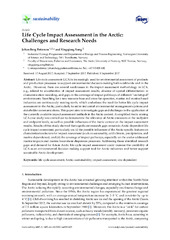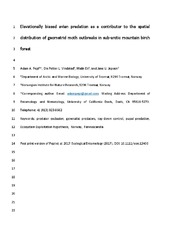Artikler, rapporter og annet (arktisk og marin biologi): Nye registreringer
Viser treff 1201-1220 av 1643
-
Changed Arctic-alpine food web interactions under rapid climate warming: implication for ptarmigan research
(Journal article; Tidsskriftartikkel; Peer reviewed, 2017-06-05)Ptarmigan are herbivorous birds that are year-round residents of alpine and arctic ecosystems — presently subjected to the most rapid climate warming on earth. Yet, compared to other bird taxa there has been little climate impact research on ptarmigan. Ptarmigan population dynamics, in particular in the sub/low-arctic, appears to be strongly influenced by complex interactions with a suite of ... -
Life cycle impact assessment in the arctic: Challenges and research needs
(Journal article; Tidsskriftartikkel; Peer reviewed, 2017-09-08)Life cycle assessment (LCA) is increasingly used for environmental assessment of products and production processes to support environmental decision-making both worldwide and in the Arctic. However, there are several weaknesses in the impact assessment methodology in LCA, e.g., related to uncertainties of impact assessment results, absence of spatial differentiation in characterization modeling, and ... -
Long-term environmental monitoring for assessment of change: measurement inconsistencies over time and potential solutions
(Journal article; Tidsskriftartikkel; Peer reviewed, 2017-10-30)The importance of long-term environmental monitoring and research for detecting and understanding changes in ecosystems and human impacts on natural systems is widely acknowledged. Over the last decades, a number of critical components for successful long-term monitoring have been identified. One basic component is quality assurance/quality control protocols to ensure consistency and comparability ... -
Microbial eukaryotes in an arctic under-ice spring bloom north of Svalbard
(Journal article; Tidsskriftartikkel; Peer reviewed, 2017-06-28)Microbial eukaryotes can play prominent roles in the Arctic marine ecosystem, but their diversity and variability is not well known in the ice-covered ecosystems. We determined the community composition of microbial eukaryotes in an Arctic under-ice spring bloom north of Svalbard using metabarcoding of DNA and RNA from the hypervariable V4 region of 18S nrDNA. At the two stations studied, the ... -
Diet and metabolic state are the main factors determining concentrations of perfluoroalkyl substances in female polar bears from Svalbard
(Journal article; Tidsskriftartikkel; Peer reviewed, 2017-06-03)Perfluoroalkyl substances (PFASs) have been detected in organisms worldwide, including Polar Regions. The polar bear (Ursus maritimus), the top predator of Arctic marine ecosystems, accumulates high concentrations of PFASs, which may be harmful to their health. The aim of this study was to investigate which factors (habitat quality, season, year, diet, metabolic state [i.e. feeding/fasting], breeding ... -
Thermal thresholds of phytoplankton growth in polar waters and their consequences for a warming polar ocean
(Journal article; Tidsskriftartikkel; Peer reviewed, 2017-06-02)Polar areas are experiencing the steepest warming rates on Earth, a trend expected to continue in the future. In these habitats, phytoplankton communities constitute the basis of the food web and their thermal tolerance may dictate how warming affects these delicate environments. Here, we compiled available data on thermal responses of phytoplankton growth in polar waters. We assembled 53 ... -
Sea trout adapt their migratory behaviour in response to high salmon lice concentrations
(Journal article; Tidsskriftartikkel; Peer reviewed, 2017-11-21)Sea trout face growth–mortality trade-offs when entering the sea to feed. Salmon lice epizootics resulting from aquaculture have shifted these trade-offs, as salmon lice might both increase mortality and reduce growth of sea trout. We studied mortality and behavioural adaptations of wild sea trout in a large-scale experiment with acoustic telemetry in an aquaculture intensive area that was fallowed ... -
Potentiation of ecological factors on the disruption of thyroid hormones by organo-halogenated contaminants in female polar bears (Ursus maritimus) from the Barents Sea.
(Journal article; Tidsskriftartikkel; Peer reviewed, 2017-06-11)As apex predators, polar bears (Ursus maritimus) are among the most heavily polluted organisms in the Arctic. In addition to this anthropogenic stressor, climate warming has been shown to negatively affect their body condition, reproductive output and survival. Among potential underlying physiological mechanisms, thyroid hormones (THs), which control thermoregulation, metabolism and reproduction, ... -
Continuous daylight in the high-Arctic summer supports high plankton respiration rates compared to those supported in the dark
(Journal article; Tidsskriftartikkel; Peer reviewed, 2017-04-28)Plankton respiration rate is a major component of global CO2 production and is forecasted to increase rapidly in the Arctic with warming. Yet, existing assessments in the Arctic evaluated plankton respiration in the dark. Evidence that plankton respiration may be stimulated in the light is particularly relevant for the high Arctic where plankton communities experience continuous daylight in spring ... -
Elevationally biased avian predation as a contributor to the spatial distribution of geometrid moth outbreaks in sub-arctic mountain birch forest
(Journal article; Tidsskriftartikkel; Peer reviewed, 2017-04-03)1. Population dynamics and interactions that vary over a species’ range are of particular importance in the context of latitudinal clines in biological diversity.Winter moth (Operophtera brumata) and autumnal moth (Epirrita autumnata) are two species of eruptive geometrids that vary widely in outbreak tendency over their range, which generally increases from south to north and with elevation. 2. ... -
Homage to Hersteinsson and Macdonald: climate warming and resource subsidies cause red fox range expansion and Arctic fox decline
(Journal article; Tidsskriftartikkel; Peer reviewed, 2017-08-16)Climate change can have a marked effect on the distribution and abundance of some species, as well as their interspecific interactions. In 1992, before ecological effects of anthropogenic climate change had developed into a topical research field, Hersteinsson and Macdonald published a seminal paper hypothesizing that the northern distribution limit of the red fox (Vulpes vulpes) is determined ... -
Snowmobile impact on diurnal behaviour in the Arctic fox
(Journal article; Tidsskriftartikkel; Peer reviewed, 2017-08-16)As tourism increases globally, studies have documented impacts on wildlife from anthropogenic disturbances. In this observational experiment we aimed to investigate if snowmobile traffic affected the diurnal activity of Arctic fox in High Arctic Svalbard. We conducted the study in two areas in Svalbard, one control area with low snowmobile traffic and one experimental area with high snowmobile ... -
Ecosystem drivers of an Arctic fox population at the western fringe of the Eurasian Arctic
(Journal article; Tidsskriftartikkel; Peer reviewed, 2017-08-16)The distribution of traditional breeding dens on the Varanger Peninsula (70–71°N) in northernmost Fennoscandia indicates that this area once harboured a large Arctic fox population. Early 20th century naturalists regarded the coastal tundra of the Fennoscandian Low Arctic to be a stronghold for the species. At the start of our research in 2004, however, the local Arctic fox population was ... -
Hooded seal Cystophora cristata foraging areas in the Northeast Atlantic Ocean—Investigated using three complementary methods
(Journal article; Tidsskriftartikkel; Peer reviewed, 2017-12-06)Identifying environmental characteristics that define the ecological niche of a species is essential to understanding how changes in physical conditions might affect its distribution and other aspects of its ecology. The present study used satellite relay data loggers (SRDLs) to study habitat use by Northeast Atlantic hooded seals (N = 20; 9 adult females, 3 adult males, and 8 juveniles). Three ... -
Gene-centromere mapping in meiotic gynogenetic European seabass
(Journal article; Tidsskriftartikkel; Peer reviewed, 2017-06-07)Background: <br> Fully isogenic lines in fish can be developed using “mitotic” gynogenesis (suppression of first zygotic mitosis following inactivation of the sperm genome). However, genome-wide verification of the steps in this process has seldom been applied. We used ddRADseq to generate SNP markers in a meiotic gynogenetic family of European seabass (Dicentrarchus labrax): (i) to verify the lack ... -
Activity of xyloglucan endotransglucosylases/hydrolases suggests a role during host invasion by the parasitic plant Cuscuta reflexa
(Journal article; Tidsskriftartikkel; Peer reviewed, 2017-04-27)The parasitic vines of the genus Cuscuta form haustoria that grow into other plants and connect with their vascular system, thus allowing the parasite to feed on its host. A major obstacle that meets the infection organ as it penetrates the host tissue is the rigid plant cell wall. In the present study, we examined the activity of xyloglucan endotransglucosylases/hydrolases (XTHs) during the ... -
Transcriptome analysis identifies key metabolic changes in the hooded seal (Cystophora cristata) brain in response to hypoxia and reoxygenation
(Journal article; Tidsskriftartikkel; Peer reviewed, 2017-01-03)The brain of diving mammals tolerates low oxygen conditions better than the brain of most terrestrial mammals. Previously, it has been demonstrated that the neurons in brain slices of the hooded seal (Cystophora cristata) withstand hypoxia longer than those of mouse, and also tolerate reduced glucose supply and high lactate concentrations. This tolerance appears to be accompanied by a shift in the ... -
Diving behaviour of Atlantic salmon at sea: effects of light regimes and temperature stratification
(Journal article; Tidsskriftartikkel; Peer reviewed, 2017-07-04)The diving behaviour of adult Atlantic salmon Salmo salar L. post-spawners in the Norwegian and Barents Seas was monitored with pop-up satellite archival tags (PSATs) and data storage tags (DSTs). Salmon from the 3 studied populations showed similar depth use patterns: tagged specimens spent most of their time near the surface (mean of 82% of the time at depths <10 m), with occasional short deep ... -
Climate warming enhances polar cod recruitment, at least transiently
(Journal article; Tidsskriftartikkel; Peer reviewed, 2017-06-27)Polar cod (Boreogadus saida) is the dominant forage fish in Arctic seas and the main prey of the ringed seal (Pusa hispida), the beluga (Delphinapterus leucas) and several seabird species. Changes in the abundance of polar cod will have cascading effects on arctic marine ecosystems. We tested the hypothesis that an earlier sea ice breakup and warmer sea surface temperatures (SST) in spring-summer ... -
Vole abundance and reindeer carcasses determine breeding activity of Arctic foxes in low Arctic Yamal, Russia
(Journal article; Tidsskriftartikkel; Peer reviewed, 2017-09-16)High latitude ecosystems are at present changing rapidly under the influence of climate warming, and specialized Arctic species at the southern margin of the Arctic may be particularly affected. The Arctic fox (Vulpes lagopus), a small mammalian predator endemic to northern tundra areas, is able to exploit different resources in the context of varying tundra ecosystems. Although generally widespread, ...


 English
English norsk
norsk


















